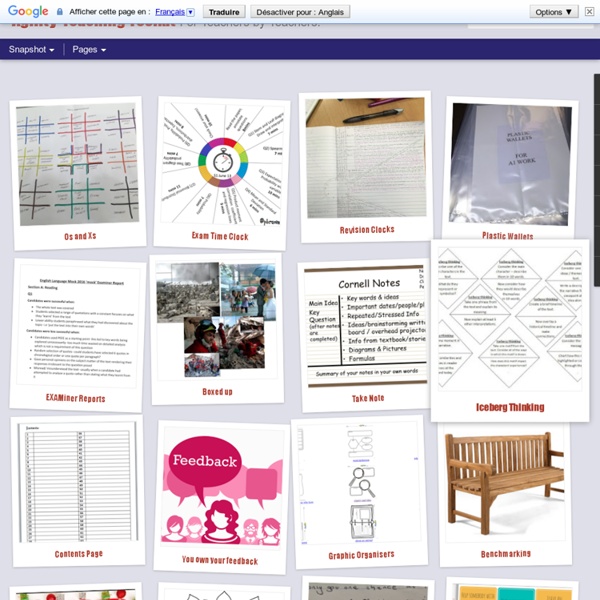



Lesson Tool Box What's New - Graphs and Transforations T&L Web Library - i2i Partnership Teaching School Follow UsFollow us on TwitterLike us on Facebook Raising standards through eye to eye partnership Science Practical (7) T&L Web Library Our guide to useful resources on the web Autonomy Marginal Learning Gains - Autonomy via Zoe Elder @fullonlearning Behaviour management Meeting your class for the first time by Tom Bennett (@tombennett71 / TES Connect) Challenge Marginal Learning Gains - Expectation via Zoe Elder @fullonlearning Feedback Top tips on marking and feedback via @TeamTait 'Connected - Issue 5' Improving written feedback via @HuntingEnglish Oral formative feedback via @HuntingEnglish Flipped Classrooms Flipped classrooms: what are they and how do they work? What's all the fuss over flipped classrooms? Top 10 Do's and Don'ts When Flipping Your Classroom - By Daniel Edwards @syded06 Homestudy Four successful homework strategies - by Christopher Waugh @Edutronic_Net Progress Ideas on how to show progress in your lesson - via Zoe Elder @fullonlearning Teaching & Learning Portals/ Blogs
Teaching Websites Educating MrMattock: Multiplicative counting - the different types In preparing for teaching the new GCSE, one of the new topics is the explicit use of multiplicative counting. While preparing problems I came to a realisation that there are 3 different types of counting here (at least before we get into the whole permutations and combinations area), and I thought I would take this opportunity to share my insight. 1) Powers for counting Students and teachers of A-Level stats modules will likely be intimately familiar with this idea through the binomial theorem. 2) Multiplying for counting This one is probably the most familiar to GCSE teachers, as it is a reasonably well used stretch for pupils on systematic listing. 3) Factorial counting. This is perhaps the one that will be least familiar, although still familiar to the A-Level aficionados amongst us; this occurs when an outcome is removed once used and the process repeated until no outcomes are left. Anne, Barry, Colin and Damien book 4 seats next to each other in the cinema as shown.
Safe is risky. | @mrocallaghan_edu Safe is risky. Very good is bad. We must be remarkable. Our students deserve nothing less. Whatever your line of work it’s not enough to just follow instructions and be a cog in a bigger machine. Let me explain a bit further. Safe is risky. Very good is bad. We must be remarkable. Schools now more then ever need teachers who don’t see teaching as a job but an art form. In order to be remarkable in the classroom we need to take risks and challenge ourselves as teachers, just as we encourage our students to. I’m currently using the following cycle to take measured (and some not so measured!) 1. 2. 3. 4. #neverstoplearning Do the students light up when they enter your classroom or when they leave? What is your art? Like this: Like Loading...
User Generated Education | Education as it should be – passion-based. Global Math Challenge: an online contest for math lovers worldwide. Why do we observe lessons? In this piece I will attempt to outline the reasoning behind formal lesson observations and moreover, the case for these lessons to be graded. There exists a human desire to measure, a need to rationalise an irrational world. In teaching, this manifests itself in the categorisation of lessons. Whilst this can sometimes be crude, I believe that it forms an important part of working out what it is that is going on in our organisations to make them either successful or unsuccessful. 1) The role of formal lesson observations 2) The case for graded lesson observations 3) Observation to support an un-standardised approach to teaching and learning The role of formal lesson observations 1) Personal development First and foremost observation serves as a developmental opportunity for the individual. 2) Sharing good practice Wherever good practice develops, it is our job to share and promote it effectively. 3) The value of the performance 4) A positive culture around observations
Resourceaholic HookED — Pam Hook – HookED Educational Consultancy